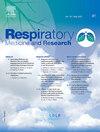Acute effects of fan therapy on exercise-induced breathlessness in healthy adults and people living with chronic respiratory disease: A systematic review
IF 1.8
4区 医学
Q3 RESPIRATORY SYSTEM
引用次数: 0
Abstract
Background
Exercise-induced breathlessness is a common complaint in the general population and a highly prevalent symptom in adults living with chronic diseases, often acting as an important barrier to engaging in physical activity. Fan therapy can reduce breathlessness at rest, yet its acute effects during exercise have not been systematically explored.
Methods
A literature search encompassing three electronic databases (PubMed, Scopus, Embase) from inception to January 2025 was conducted to identify randomized controlled trials comparing fan therapy during and after an acute exercise bout to a control condition, on dyspnea and exercise capacity. Relevant conference abstracts were considered. Risk of bias was assessed via the Physiotherapy Evidence Database scale. The PRISMA guidelines were followed.
Results
A total of six studies, including one conference abstract, met eligibility criteria. Five records involved 79 adults with chronic respiratory disease, all presenting a respiratory disease, and the remaining record included 10 healthy individuals. The results were generally consistent, showing that fan therapy significantly reduces exercise-induced breathlessness (n = 2 studies), decreases breathlessness during recovery (n = 5), and enhances exercise capacity (n = 2). The methodological quality was good for half or retrieved studies and poor-to-fair in the other half.
Conclusion
Fan therapy might relieve dyspnea and improve exercise capacity during and after an acute bout of exercise in patients with chronic respiratory disease. Future high-quality research should confirm these findings and consider assessing fan therapy effects in other populations. PROSPERO number: CRD42023475117
风扇疗法对健康成人和慢性呼吸系统疾病患者运动诱导呼吸困难的急性影响:一项系统综述
背景:运动引起的呼吸困难是普通人群中一种常见的主诉,也是成人慢性疾病患者中一种非常普遍的症状,经常成为参与体育活动的重要障碍。风扇疗法可以减少休息时的呼吸困难,但其在运动中的急性效果尚未得到系统的探索。方法检索PubMed、Scopus、Embase三个电子数据库从成立到2025年1月的文献,以确定随机对照试验,比较风扇治疗在急性运动期间和之后对呼吸困难和运动能力的影响。审议了有关的会议摘要。通过物理治疗证据数据库量表评估偏倚风险。遵循了PRISMA准则。结果共有6项研究符合入选标准,其中包括1项会议摘要。5项记录涉及79名患有慢性呼吸道疾病的成年人,他们都表现出呼吸道疾病,其余记录包括10名健康个体。结果基本一致,显示风扇疗法显著减少运动引起的呼吸困难(n = 2项研究),减少恢复期间的呼吸困难(n = 5),并增强运动能力(n = 2)。一半或检索研究的方法学质量良好,另一半研究的方法学质量较差。结论风扇疗法可缓解慢性呼吸系统疾病患者急性发作时及发作后的呼吸困难,提高运动能力。未来的高质量研究应该证实这些发现,并考虑评估风扇治疗在其他人群中的效果。普洛斯彼罗号码:CRD42023475117
本文章由计算机程序翻译,如有差异,请以英文原文为准。
求助全文
约1分钟内获得全文
求助全文
来源期刊

Respiratory Medicine and Research
RESPIRATORY SYSTEM-
CiteScore
2.70
自引率
0.00%
发文量
82
审稿时长
50 days
 求助内容:
求助内容: 应助结果提醒方式:
应助结果提醒方式:


